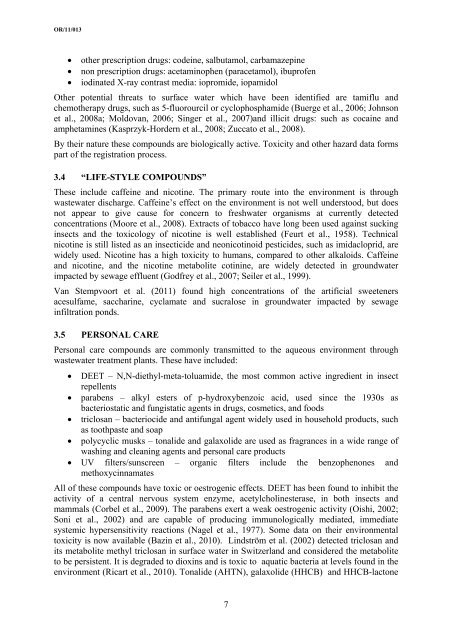Emerging contaminants in groundwater - NERC Open Research ...
Emerging contaminants in groundwater - NERC Open Research ...
Emerging contaminants in groundwater - NERC Open Research ...
Create successful ePaper yourself
Turn your PDF publications into a flip-book with our unique Google optimized e-Paper software.
OR/11/013<br />
other prescription drugs: code<strong>in</strong>e, salbutamol, carbamazep<strong>in</strong>e<br />
non prescription drugs: acetam<strong>in</strong>ophen (paracetamol), ibuprofen<br />
iod<strong>in</strong>ated X-ray contrast media: iopromide, iopamidol<br />
Other potential threats to surface water which have been identified are tamiflu and<br />
chemotherapy drugs, such as 5-fluorourcil or cyclophosphamide (Buerge et al., 2006; Johnson<br />
et al., 2008a; Moldovan, 2006; S<strong>in</strong>ger et al., 2007)and illicit drugs: such as coca<strong>in</strong>e and<br />
amphetam<strong>in</strong>es (Kasprzyk-Hordern et al., 2008; Zuccato et al., 2008).<br />
By their nature these compounds are biologically active. Toxicity and other hazard data forms<br />
part of the registration process.<br />
3.4 “LIFE-STYLE COMPOUNDS”<br />
These <strong>in</strong>clude caffe<strong>in</strong>e and nicot<strong>in</strong>e. The primary route <strong>in</strong>to the environment is through<br />
wastewater discharge. Caffe<strong>in</strong>e’s effect on the environment is not well understood, but does<br />
not appear to give cause for concern to freshwater organisms at currently detected<br />
concentrations (Moore et al., 2008). Extracts of tobacco have long been used aga<strong>in</strong>st suck<strong>in</strong>g<br />
<strong>in</strong>sects and the toxicology of nicot<strong>in</strong>e is well established (Feurt et al., 1958). Technical<br />
nicot<strong>in</strong>e is still listed as an <strong>in</strong>secticide and neonicot<strong>in</strong>oid pesticides, such as imidacloprid, are<br />
widely used. Nicot<strong>in</strong>e has a high toxicity to humans, compared to other alkaloids. Caffe<strong>in</strong>e<br />
and nicot<strong>in</strong>e, and the nicot<strong>in</strong>e metabolite cot<strong>in</strong><strong>in</strong>e, are widely detected <strong>in</strong> <strong>groundwater</strong><br />
impacted by sewage effluent (Godfrey et al., 2007; Seiler et al., 1999).<br />
Van Stempvoort et al. (2011) found high concentrations of the artificial sweeteners<br />
acesulfame, sacchar<strong>in</strong>e, cyclamate and sucralose <strong>in</strong> <strong>groundwater</strong> impacted by sewage<br />
<strong>in</strong>filtration ponds.<br />
3.5 PERSONAL CARE<br />
Personal care compounds are commonly transmitted to the aqueous environment through<br />
wastewater treatment plants. These have <strong>in</strong>cluded:<br />
DEET – N,N-diethyl-meta-toluamide, the most common active <strong>in</strong>gredient <strong>in</strong> <strong>in</strong>sect<br />
repellents<br />
parabens – alkyl esters of p-hydroxybenzoic acid, used s<strong>in</strong>ce the 1930s as<br />
bacteriostatic and fungistatic agents <strong>in</strong> drugs, cosmetics, and foods<br />
triclosan – bacteriocide and antifungal agent widely used <strong>in</strong> household products, such<br />
as toothpaste and soap<br />
polycyclic musks – tonalide and galaxolide are used as fragrances <strong>in</strong> a wide range of<br />
wash<strong>in</strong>g and clean<strong>in</strong>g agents and personal care products<br />
UV filters/sunscreen – organic filters <strong>in</strong>clude the benzophenones and<br />
methoxyc<strong>in</strong>namates<br />
All of these compounds have toxic or oestrogenic effects. DEET has been found to <strong>in</strong>hibit the<br />
activity of a central nervous system enzyme, acetylchol<strong>in</strong>esterase, <strong>in</strong> both <strong>in</strong>sects and<br />
mammals (Corbel et al., 2009). The parabens exert a weak oestrogenic activity (Oishi, 2002;<br />
Soni et al., 2002) and are capable of produc<strong>in</strong>g immunologically mediated, immediate<br />
systemic hypersensitivity reactions (Nagel et al., 1977). Some data on their environmental<br />
toxicity is now available (Baz<strong>in</strong> et al., 2010). L<strong>in</strong>dström et al. (2002) detected triclosan and<br />
its metabolite methyl triclosan <strong>in</strong> surface water <strong>in</strong> Switzerland and considered the metabolite<br />
to be persistent. It is degraded to diox<strong>in</strong>s and is toxic to aquatic bacteria at levels found <strong>in</strong> the<br />
environment (Ricart et al., 2010). Tonalide (AHTN), galaxolide (HHCB) and HHCB-lactone<br />
7

















